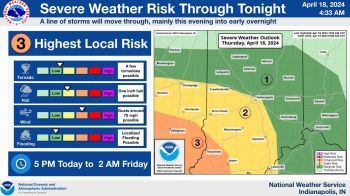GREENWOOD, Ind.–You might remember hearing about a Hoosier who caught Rocky Mountain Spotted Fever and died last year. This year, more people in Indiana are getting tick-related diseases, and some of them can make you pretty sick.
“This year we haven’t had any fatal cases. But, I had a case that acquired it in Greenwood. We’ve never seen a case in Greenwood,” said Dr. John Christenson, infectious disease physician at Riley Children’s Health.
More than 100 cases of tick-borne disease have been reported so far in 2018, including one death due to ehrlichiosis in an elderly patient, said a news release from the Indiana State Dept. of Health.. Deaths from ehrlichiosis are rare in Indiana, with only four deaths reported in the last five years.
“Lyme disease is always around,” said Christenson. “Seventeen years ago when I got here, there was no Lyme disease (in Indiana), and that’s basically emerged over the last seven to eight years.”
“Cases of tick-borne disease tend to peak in July,” said Jennifer Brown, D.V.M., M.P.H., state public health veterinarian at the Indiana State Department of Health. “You should take precautions to prevent tick bites whenever you spend time outdoors. Call your health care provider right away if you develop a flu-like illness or a rash during the summer months.”
Symptoms of tick-borne diseases can include a rash near the bite site and feeling like you have the flu, with headache, muscle or joint pain and fever.
Christenson said both tick and mosquito-borne viruses tend to happen in the summer, when the insects are more prolific.
“The challenge is going to be for clinicians to say, okay, do you have arbovirus, do you have enterovirus (transmitted through the intestines), do you have West Nile or do you have something else,” said Christenson. “If we can find very quickly what the patient has, then we can avoid using unnecessary medications.”
Audio titled JOHN CHRISTENSON TICKS AND MOSQUITOES by 93WIBC
The State Dept. of Health said you should dry your clothes on high heat for 30 minutes to kill any ticks on clothing after you’ve been outside.
To safely remove a tick, use tweezers to grasp the tick close to the skin and then pull outward with steady and even pressure. After the tick is removed, wash the area thoroughly. The tick should be discarded by submerging it in alcohol, placing it in a sealed bag or container, wrapping it tightly in tape or flushing it down the toilet. Ticks should never be crushed with the fingernails.
Hoosiers can reduce their risk of tick bites by:
- Wearing a long-sleeved shirt and light-colored pants, with the shirt tucked in at the waist and the pants tucked into socks, if they will be in grassy or wooded areas.
- Treating clothing and outdoor gear with 0.5{e0016bc526488076cccec5187651e4db422187ce89e640e1eb2a2519a6ce4707} permethrin, an insect repellent commonly used for this purpose. Note that permethrin should NOT be used on bare skin.
- Using EPA-registered insect repellents with active ingredients such as DEET, picaridin, IR3535, oil of lemon eucalyptus (OLE), para-menthane-diol (PMD) or 2-undecanone.
PHOTO: Thinkstock/Victor Cap












